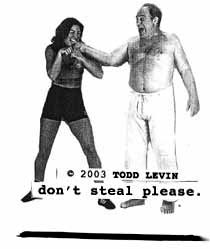


|
|
HOW TO MAKE THUNDER.
Just over the Pennsylvania border in Shohola, where displaced New Yorkers marvel a bit too loudly over the price of beer ("Only six dollars for a pitcher of Yeungling? SUCKERS!!"), there is a bar called Rohman's. The bar has stood in this spot since 1849, and smells like it. It's that aromatic mixture of cigarette smoke, traces of domestic beer, and the dust that settles on antique furniture. Upstairs, impossibly, are four bowling lanes. The bowling alley looks like a church where people worship strikes and beer. It was constructed in 1941, before the invention of automatic ball returns and machine-operated pinsetting. Here, the pins are set using a hidden foot lever behind the lane. When the foot lever is depressed it engages a pyramid of twelve dull spikes set into the floor. The pins rest on the spikes and, when you've set all ten, you release the lever and the spikes disappear into the floorboards again. After a player rolls, the ball drops to the floor behind the pins and the pinsetter sends it back along thin wooden rollercoaster rails that drop off quickly enough to give the ball a decent amount of momentum on its return. Bowling is by reservation, and the bar hires its own freelance pinsetting staff—in our case a pair of small boys, one no more than seven years old. I'm not sure what the child labor laws in Pennsylvania are, and if they're suspended for certain industries like recreation, but those kids worked harder than the average advertising executive. (We compensated them in Laffy Taffy and centipedes we'd caught in mayonnaise jars.) Since we had such a large group of bowlers, we needed to commandeer three lanes. That left us one toddler short for pinsetting, so while one of person supplied the kids with pitchers of Coke, a few of us took turns pinsetting for our extra lane. I was happy to volunteer because I was curious about the mechanics of it. The mechanics were, of course, pretty rudimentary and easily absorbed, but I continued to volunteer just to eavesdrop on the kids' patter and keep myself occupied in a large group of friends where I was one of the only people un-coupled. (I have to confess it was also kind of mesmerizing to watch the pins explode on impact from such a close distance. There seemed to be no law governing how pins would react. Some would topple over like drunks, while others would cartwheel across the entire lane, taking out a pin or two behind it on its way. I tried to follow them and see if individual pins exhibited any kind of pattern of behavior, but it just became too difficult to single out pins by a smudge or chip. After a while I just enjoyed the quick smash of chaos.) The older, more experienced pinsetter—he was probably twelve or thirteen—really rode the new kid. (Who could very well have been a younger brother, as they both had matching blonde brush cuts.) The seven year-old had never done this before and couldn't work fast enough for his boss. "You gotta move faster. Faster. Faster," the twelve year-old repeated as his co-worker struggled to keep the spikes engaged with his foot while fully extending his back leg, and stretching forward to set the one-pin. At one point I heard the older boy say, "Man, you gotta stop sweating. You can't lose any more weight." I sweat all the time, and was probably sweating while perched over lane three, waiting for the pins to fall, but didn't even realize children that small even perspired. There's something particularly sad about a kid working so hard he's breaking a sweat. You know he'd rather be outdoors poking toads or throwing dirtbombs at school buses. But he was a good sport, and very polite—both pinsetters were—and after the game we pooled our money together to give our indentured servants a generous tip. I expect a seven year-old rarely gets his hands on that kind of money, particularly in a town filled with suckers who only charge two dollars for a pint of beer. |


